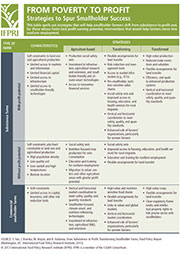Small farms play an indispensable role in global food security, particularly in developing countries. In fact, according to the UN Food and Agriculture Organization (FAO), four-fifths of the developing world’s food is a product of small-sized farms. That said, not all smallholder farms are cut from the same cloth and strategies that help shift small farms from subsistence to profit should be considered alongside interventions, like non-farm employment, for those whose farms lack profit-earning potential.
Recognizing that smallholders are less likely to take risks and thus skew towards subsistence, Shenggen Fan (director general of IFPRI), Joanna Brzeska (consultant researcher at IFPRI), Michiel Keyzer (director of the Centre for World Food Studies of the Vrije Universiteit (SOW-VU)), and Alex Halsema (researcher at the Centre for World Food Studies at SOW-VU), offer a set of policy recommendations in their Food Policy Report, From Subsistence to Profit: Transforming Smallholder Farms, to both help smallholder farmers with profit potential undertake more commercial activities as well as guide those who are grappling with the search for employment opportunities off the farm.
According to the authors, it’s important to shift the context in which we view smallholders. It’s not a matter of small versus large farms but rather understanding that the ideal farm size is “a dynamic concept that changes as a country’s overall economy grows and as nonagricultural sectors develop.” To illustrate this, the authors present a typology of various development strategies and interventions.
The authors also offer several policy recommendations to help potentially profitable smallholders meet emerging risks and challenges, including the need to loosen rental market regulations, strengthen smallholder links to input and output markets, and endorse land titling programs. Supporting social safety nets, such as vocational training and conditional and unconditional cash transfer programs, is also important to smallholder success.
Fickle weather patterns, and climate change in general, disproportionally impact smallholders, particularly due to their limited resource base to absorb such shocks. This makes access to tools such as flexible insurance crucial to managing such threats. The uncertainty wrought by volatile food prices is especially problematic for smallholders because “although some smallholder farmers with marketable surplus stand to profit from rising food prices, the volatility and uncertainty of prices make it difficult for them to take advantage of these opportunities.”
An integrated approach to agriculture, nutrition, and health is another key policy recommendation. As the authors write, “Development efforts over the past several decades have focused on providing an adequate supply of food through improved agricultural productivity, but they have failed to deliver adequate quantities of nutritionally balanced food, especially to poor people.”
The authors also emphasize the importance of mechanisms that improve smallholder access to market information and bargaining power, such as producer associations, group lending, and information and communication technologies (ICTs). And, they stress the need for smallholder-friendly forms of financing and investment, since limited access to finance and capital presents another major barrier for smallholders, leaving them particularly vulnerable to shocks.
Related links







